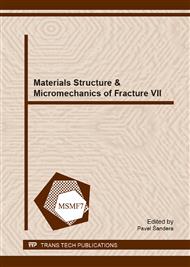p.283
p.287
p.291
p.295
p.301
p.307
p.313
p.317
p.321
Strength Hierarchy for Nano-Sized Crystals
Abstract:
A concept of atomic mechanisms governing strength of nanosized defect-free crystals is presented. It is exhibited that these mechanisms consist in local instability of the lattice. Two main reasons for localization of instability in three-dimension (3D) crystals are analyzed, namely, (i) fluctuation of local stresses induced by thermal vibrations of atoms, and (ii) non-uniform distribution of local stresses caused by a surface tension. Based on this conception, explanations of both the temperature dependence of strength of 3D nanocrystals and scale effect are given. Ideas on the reasons for and regularities of change in strength at transition from 3D to 2D (graphene) and 1D (monatomic chain) crystals are represented. It is shown that dimensionality of crystal is one of the main factors governing strength of defect-free crystals. Experimental values of the strength of carbon monatomic chains are given, which times exceeds the strength of graphene and is the highest attainable level of strength in the world.
Info:
Periodical:
Pages:
301-306
Citation:
Online since:
November 2013
Keywords:
Price:
Сopyright:
© 2014 Trans Tech Publications Ltd. All Rights Reserved
Share:
Citation:



